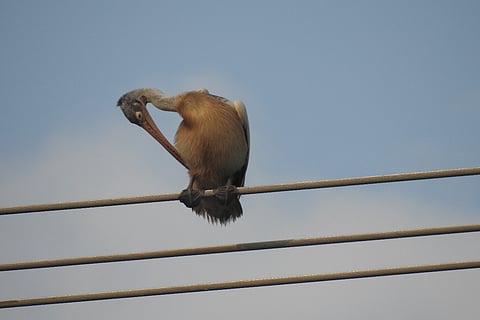

Environmentalists found seven nests with 25 baby pelicans and one nest of a white-bellied eagle, a threatened species, on top of newly built transmission towers in Kattupalli and Ennore lagoons in Tamil Nadu. The nests were identified by members of the Save Ennore Creek campaign during a recent field study at the rapidly industrialising Ennore-Pulicat wetlands complex. With this, the members wrote to the Tamil Nadu Chief Wildlife Warden asking for the eco-sensitive zone around the Pulicat Sanctuary to be extended from the current 10 kms from sanctuary boundaries “to cover all areas of conservation importance within the Ennore-Pulicat wetlands complex.”
A white-bellied eagle and its nest on a power transmission tower.
Save Ennore Creek’s field survey was aimed at identifying critical nesting and roosting sites of endangered wetland birds in the Ennore-Pulicat wetlands complex, which spans 8,000 acres in the north of Chennai. While the pelican nests were found to the south of Kamarajar Port’s Gate 2, the white bellied eagle’s nest was found in the “ash-choked wetlands opposite to the North Chennai Thermal Power Station,” said Nityanand Jayaraman, a Chennai-based activist who has been raising awareness about the industrialisation of the Ennore-Pulicat wetlands complex.
These findings highlight the importance of the Kosasthalaiyar river’s backwaters as a critical wetland habitat for migratory birds and endangered species. The team that conducted the field survey included naturalists M Yuvan and Rohith Srinivasan, and social activists K Saravanan and Nityanand Jayaraman. Apart from the nests on pylons (transmission towers), the team also identified flocks of garganeys, painted storks, open-billed storks, pacific golden plovers, pelicans, black-headed ibis, Little Temminck’s stint in a mosaic of habitats including mudflats, ponds, streams, backwaters and thorny scrub within the Eco-Sensitive Zone (ESZ) of the Pulicat Sanctuary.
In a letter to Shekhar Kumar Niraj, the Chief Wildlife Warden of Tamil Nadu, the team highlighted that they had also found garbage and untreated sewage being dumped indiscriminately into the backwaters by contractors housing labour camps for the workforce from the L&T and Adani ports. “Several thousand workers are housed in unhygienic and unapproved labour camps constructed on eco-sensitive sand dunes with no proper sewage facilities,” the activists said in a statement.
The letter also states that the Tamil Nadu Pollution Control Board is responsible for ensuring the Solid Waste Rules, 2016, and the Water (Prevention and Control of Pollution) Act, which prevents discharge of untreated effluents. “Far from being a well-regulated buffer to protect the sanctuary, the ESZ is a free-for-all with no enforcement oversight by the TNPCB or local body,” the statement says, calling for stricter monitoring.